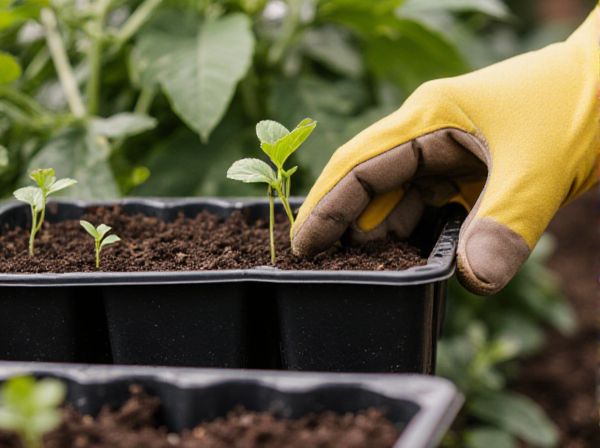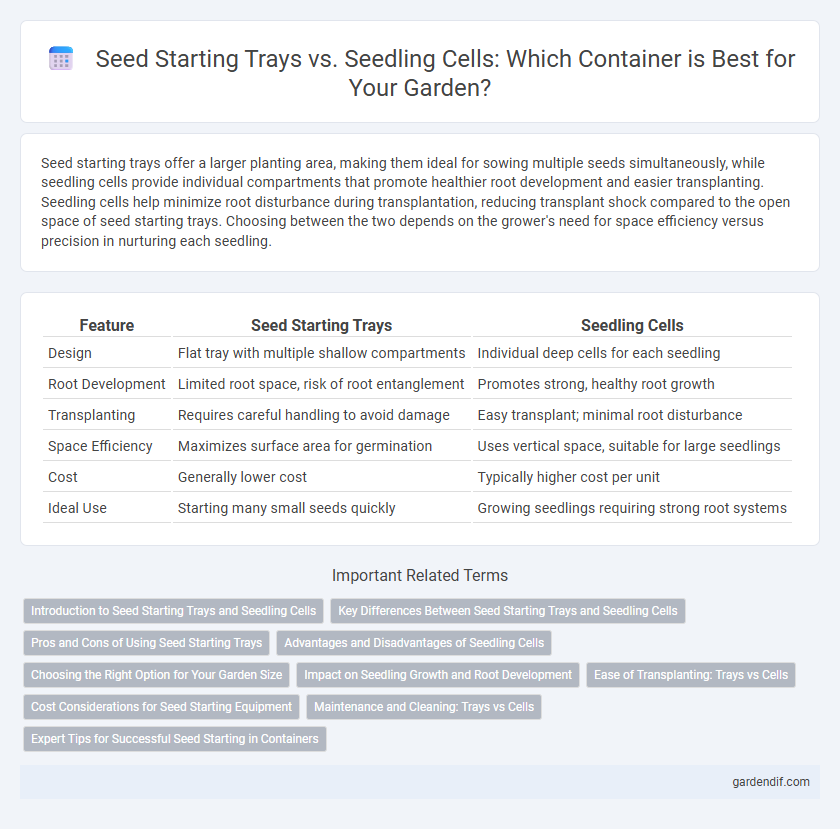
Seed starting trays vs seedling cells Illustration
Seed starting trays offer a larger planting area, making them ideal for sowing multiple seeds simultaneously, while seedling cells provide individual compartments that promote healthier root development and easier transplanting. Seedling cells help minimize root disturbance during transplantation, reducing transplant shock compared to the open space of seed starting trays. Choosing between the two depends on the grower's need for space efficiency versus precision in nurturing each seedling.
Table of Comparison
| Feature | Seed Starting Trays | Seedling Cells |
|---|---|---|
| Design | Flat tray with multiple shallow compartments | Individual deep cells for each seedling |
| Root Development | Limited root space, risk of root entanglement | Promotes strong, healthy root growth |
| Transplanting | Requires careful handling to avoid damage | Easy transplant; minimal root disturbance |
| Space Efficiency | Maximizes surface area for germination | Uses vertical space, suitable for large seedlings |
| Cost | Generally lower cost | Typically higher cost per unit |
| Ideal Use | Starting many small seeds quickly | Growing seedlings requiring strong root systems |
Introduction to Seed Starting Trays and Seedling Cells
Seed starting trays and seedling cells serve as essential containers for nurturing young plants by providing an organized space for germination and early growth. Seed starting trays are typically flat with multiple shallow compartments allowing for the sowing of numerous seeds simultaneously, promoting efficient use of space and uniform moisture. Seedling cells, on the other hand, feature deeper individual compartments designed to support root development and reduce transplant shock by keeping seedlings separated until they are ready for planting.
Key Differences Between Seed Starting Trays and Seedling Cells
Seed starting trays are shallow containers typically used for sowing multiple seeds in a single compartment, allowing for easy watering and germination of various plants simultaneously. Seedling cells consist of individual compartments, promoting better root development by preventing root entanglement and facilitating easier transplanting without disturbing neighboring seedlings. The main key difference lies in their structure: trays provide a large flat surface suitable for dense planting, whereas seedling cells offer separated spaces for each seedling, enhancing growth quality and minimizing transplant shock.
Pros and Cons of Using Seed Starting Trays
Seed starting trays offer the advantage of accommodating multiple seedlings in a single container, promoting efficient space use and uniform watering; however, they may lead to root crowding and increased risk of disease spread compared to individual seedling cells. Their shallow design facilitates quicker germination but can cause rapid soil drying, requiring consistent moisture monitoring. While seed starting trays are cost-effective and easy to handle, they lack the individualized soil conditions and root development support that seedling cells provide.
Advantages and Disadvantages of Seedling Cells
Seedling cells offer precise root development by providing individual compartments that reduce root disturbance and transplant shock, enhancing seedling survival rates. Their rigid structure supports optimal aeration and water drainage but typically requires more storage space and higher initial cost compared to seed starting trays. While seedling cells facilitate easier labeling and monitoring of different plant varieties, they can limit seed quantity per tray, potentially reducing large-scale sowing efficiency.
Choosing the Right Option for Your Garden Size
Seed starting trays offer a broad planting surface ideal for gardeners with limited space, allowing numerous seeds to germinate in a compact area. Seedling cells provide individual compartments that promote stronger root development and reduce transplant shock, making them suitable for larger gardens with diverse plant needs. Selecting between trays and cells depends on garden size and plant type, optimizing seedlings' growth and transplant success.
Impact on Seedling Growth and Root Development
Seed starting trays provide ample space for root expansion, promoting robust root systems and reducing transplant shock. Seedling cells, with individual compartments, minimize root disturbance and encourage healthy, uniform growth by isolating each plant. Both container types influence seedling vigor, but cells offer better root management for delicate or slow-growing species.
Ease of Transplanting: Trays vs Cells
Seedling cells offer superior ease of transplanting compared to seed starting trays by allowing gardeners to separate individual plants without disturbing root systems. The structured compartments minimize root entanglement, reducing transplant shock and promoting healthier plant establishment. Seed starting trays, with their larger undivided spaces, often require more careful handling to avoid damaging adjacent seedlings during transplantation.
Cost Considerations for Seed Starting Equipment
Seed starting trays generally offer a lower upfront cost compared to individual seedling cells, making them an economical choice for gardeners on a budget. Seedling cells, while more expensive, provide better root development and reduce transplant shock, potentially saving money by increasing successful seedling growth rates. Balancing cost with efficiency depends on the scale of planting and the desired quality of seedling establishment.
Maintenance and Cleaning: Trays vs Cells
Seed starting trays require more thorough cleaning between uses due to their larger surface area, which can harbor soilborne pathogens and algae more easily. Seedling cells, being individual compartments, often reduce cross-contamination risk but demand detailed attention to clean each cell thoroughly to prevent disease spread. Regular maintenance of both types, including sterilization with diluted bleach or hydrogen peroxide solutions, is essential to promote healthy seedling development and prevent fungal infections.
Expert Tips for Successful Seed Starting in Containers
Choose seed starting trays with individual seedling cells to promote optimal root development and prevent root disturbance during transplanting. Use trays with deep, well-draining cells to ensure adequate moisture retention and reduce the risk of damping-off disease. Sterilize containers before use to minimize pathogen presence and select lightweight, durable materials for efficient handling and reuse.
Seed starting trays vs seedling cells Infographic

 gardendif.com
gardendif.com